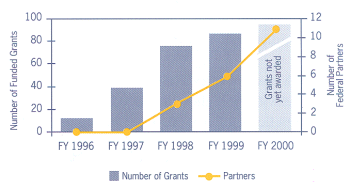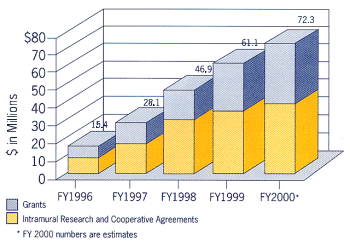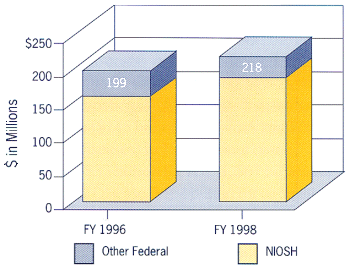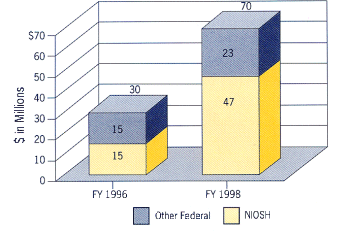NORA: National Occupational Research Agenda
November 2000
DHHS (NIOSH) Publication Number 2001-101

Background
In April 1996, The National Institute for Occupational Safety and Health (NIOSH) and its partners unveiled the National Occupational Research Agenda (NORA), a framework to guide occupational safety and health research into the next decade. NORA is a tool not only for NIOSH but for the entire occupational safety and health community. Approximately 500 organizations and individuals outside NIOSH provided input into the development of the Agenda. Prior to NORA, there had been no national research agenda in the field of occupational safety and health (nor any other field) which had captured such broad input and consensus. This unique process resulted in remarkable agreement about the top 21 research priorities (see box below).
NORA Priority Research Areas
Disease and Injury:
- Allergic and Irritant Dermatitis
- Asthma and Chronic Obstructive Pulmonary Disease
- Fertility and Pregnancy Abnormalities
- Hearing Loss
- Infectious Diseases
- Low Back Disorders
- Musculoskeletal Disorders of the Upper Extremities
- Traumatic Injuries
Work Environment and Workforce:
- Emerging Technologies
- Indoor Environment
- Mixed Exposures
- Organization of Work
- Special Populations at Risk
Research Tools and Approaches:
- Cancer Research Methods
- Control Technology and Personal Protective Equipment
- Exposure Assessment Methods
- Health Services Research
- Intervention Effectiveness Research
- Risk Assessment Methods
- Social and Economic Consequences of Workplace Illness and Injury
- Surveillance Research Methods
NORA arose out of a need to address the changes in the U.S. workplace as well as the increasingly diversified workforce. The distribution of jobs in the U.S. economy continues to shift from manufacturing to services. Longer hours, compressed workweeks, shiftwork, reduced job security, and part-time and temporary work are realities of the modern workplace. The U.S. workforce will grow to an estimated 147 million by the year 2005, with minorities representing 28 percent of the workforce and with women representing approximately 48 percent.
NORA also provides a means to target research in areas with the highest likelihood of reducing the still significant toll of workplace illness and injury. Each day, an average of 9,000 workers sustain disabling injuries on the job, 17 workers die from a workplace injury, and 137 workers die from work-related diseases. These injuries and deaths continue to inflict a tremendous toll in both human and economic costs. A NIOSH-funded study published in 1997 showed that indirect and direct costs of occupational injuries and illnesses totaled $171 billion ($145 billion for injuries and $26 billion for diseases) in 1992. These costs compare to $33 billion for AIDS, $67 billion for Alzheimer’s Disease, $164 billion for circulatory diseases, and $171 billion for cancer.
These numbers alone point to the need for continued occupational safety and health research. However, research efforts in both the public and private sector face limited fiscal resources. Through NORA and its collaborative structure the nation is better positioned to address the toll of workplace injury, illness, and death.
Implementation
The development of NORA was only the first step in the effort between NIOSH and its many partners to guide and promote occupational safety and health research. Since NORA was announced, there has been a common commitment to implement the Agenda, primarily by increasing activities and resources in the 21 priority areas.
Twenty Partnership Teams (the two musculoskeletal priority research areas are being addressed by one team) were formed to assist in the implementation of the Agenda. Each team consists of a team leader, NIOSH researchers, and external partners. The 20 Partnership Teams have brought together approximately 130 NIOSH researchers and 170 external members including representatives from academia, labor, industry, health and safety organizations, the insurance industry, and other government organizations.
The Partnership Teams have also had much success in collaborating with key stakeholders, defining research needs, and leveraging resources for research. Sixteen NORA teams (covering 17 priority areas) have published or are writing white papers and NIOSH and its partners have sponsored 34 major meetings related to N0RA as a whole or to specific priority areas. In addition to white papers, conferences, and workshops, teams are also developing surveys, establishing graduate-level training programs, participating in continuing medical education workshops, and developing other documents.
A NORA Liaison Committee and a Federal Liaison Committee also have important roles in the implementation of NORA. Both committees provide outreach and help guide the progress and direction of NORA implementation.
Grant Funding
NORA has been successful in stimulating new research needed to address the problem of workplace injuries and illnesses. A major initiative was started in FY 1998 when NIOSH and three federal partners awarded grants totalling nearly $8 million in ten NORA priority research areas. This was the largest infusion of funding ever by the federal government for extramural occupational safety and health research.
NIOSH built on these partnerships in FY 1999 and jointly announced two Requests for Applications (RFA) with six other federal agencies: National Cancer Institute (NCI); National Heart, Lung, and Blook Institute (NHLBI); National Institute on Aging (NIA); National Institute on Deafness and Other Communication Disorders (NIDCD); National Institute of Environmental Health Sciences (NIEHS), and the Environmental Protection Agency (EPA).
A total of about $9 million was awarded to support 33 grants in eight NORA priority areas. In addition to these RFAs, NIOSH awarded another 53 grants that address NORA priority areas under the Institute’s general grants Program Announcement (PA). These grant figures represent new grants each year in the NORA priority areas. A more complete picture of the NORA grants program includes both new and continuing NORA grants. When both categories are included, the total grant funding for FY 1998 is $16.8 million and $26.7 million for FY 1999.
NORA Grants/Partners FY 1996-FY 2000

In FY 2000, NIOSH and eight NIH partners have solicited applications in all 21 NORA priority areas under a general PA. The amount of grant funding will depend on the number of quality applications received. The NIH Institutes included in the announcement are NCI, NHLBI, NIA, National Institute on Alcohol Abuse and Alcoholism (NIAAA), National Institute of Allergy and Infectious Diseases (NIAID), National Institute of Arthritis and Musculoskeletal and Skin Diseases (NIAMS), NIDCD, and NIEHS. In addition to the PA, NIOSH and seven co-sponsors announced about $10 million for research related to Special Populations at Risk and Mixed Exposures. NIOSH is also targeting about $8 million for additional RFAs which focus on 11 of the NORA priority areas.
NIOSH NORA Funding
In FY 1996, at the time the Agenda was unveiled, the NIOSH baseline investment in the NORA priority areas was $15.4 million (approximately 9 percent of the FY 1996 budget). Of this, $8.7 million was devoted to intramural research (NIOSH-conducted) and cooperative agreements (NIOSH-funded extramural research in which NIOSH directly participates), and $6.7 million for research grants (extramural investigator-initiated projects). A redirection of resources in FY 1997 nearly doubled this investment to $28.1 million. A new $5 million special Congressional appropriation to NIOSH in FY 1998 for NORA, coupled with additional reinvestment of baseline monies into NORA priority areas, resulted in $46.9 million of research (about 25 percent of the budget) in NORA priority areas for FY 1998.
In FY 1999, continued Congressional support for NORA, as well as ongoing internal resource allocation, resulted in $61.1 million of NIOSH research funds (31 percent of the budget) directed at NORA priority areas. In FY 2000, an $11.3 million ongressional appropriation for NORA contributed to the estimated $72.3 million allocated to NORA priorities (34 percent of the NIOSH budget).
Such an increase is tangible evidence of NIOSH’s commitment to NORA. This shift is particularly notable given existing Congressional mandates and obligations that limit how much of the NIOSH budget can be redirected. An ongoing effort has been in place since NORA’s inception to assure that these shifts are “real” (rather than merely a reporting artifact) using consistent definitions and an independent evaluation team to assess projects for NORA-relatedness.
NIOSH NORA Investment

Federal OS&H Spending FY 96 and FY 98

Other Federal Funding
As part of NORA, a survey of Federal occupational safety and health research is conducted biennially. The first survey, covering FY 96, provided a baseline identifying a total of only $39 million spent for all occupational safety and health research outside of NIOSH for a total Federal investment of $199 million. The second survey identified the total spending in occupational safety and health research by Federal agencies as $218 million in FY 1998 (NIOSH $187 million and other Federal agencies $31 million). The FY 1996 baseline for NORA-related research from non-NIOSH Federal sources was about $15 million, increasing in FY 1998 to $23.4 million.
Federal partners will continue to perform the survey biennially, with the next survey assessing FY 2000 expenditures.
Federal NORA Spending FY 1996 and FY 1998

Selected Accomplishments
- In 1998, NORA was selected as a seminfinalist for the prestigious Innovations in American Government Award sponsored by the Ford Foundation and administered by Harvard University’s John F. Kennedy School of Government.
- Many organizations use NORA as a model for creating research agendas or other types of partnership and planning. Examples include the European Agency for Safety and Health at Work, the Department of Defense, the Japanese National Institute of Industrial Health, the state of Maine, and the Chemical Industry Institute of Toxicology.
- Federal funding for NORA increased 133 percent from $30 million in FY 1996 to $70 million in FY 1998.
- Federal NORA funding partners increased from three in FY 1998 to 11 in FY 2000.
- In 1999, the NORA Partnership Award for Worker Health and Safety was instituted (awarded biennially).
